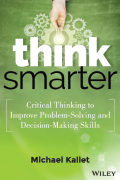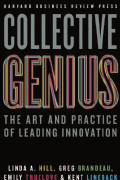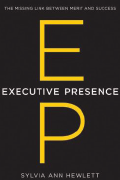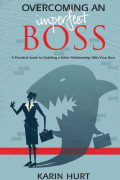TD Magazine Article
A Thoughtful Process
A review of Think Smarter: Critical Thinking to Improve Problem-Solving and Decision-Making Skills by Michael Kallet
Fri Aug 08 2014

Think Smarter: Critical Thinking to Improve Problem-Solving and Decision-Making Skills
By Michael Kallet
Wiley, 217 pp., $25
Unless your professional career has taken place under a rock, you know that critical thinking is highly valued in the workplace. After all, employers don't want a group of robots working for them. But stepping up the level of critical thinking and innovation at any organization is a difficult task.
Fortunately, critical thinking is a skill that can be methodically developed. In Think Smarter, Kallet, a critical thinking consultant, presents a simple, straightforward process for improving critical thinking. His approach is based on a decade of conducting critical thinking workshops for organizations in a wide range of industries. His framework is designed for self-driven learning within the course of a typical workday, but also can be adapted for group or one-on-one training sessions.
Kallet eschews an academic approach ("left brain/right brain, neurochemical stuff") to critical thinking, and gets right down to a method for solving problems in the real world.
His approach has three components: clarity, conclusions, and decisions. Kallet claims that we give way too often to "automatic thinking," listing examples from the workplace that will sound familiar to any professional. We place too much value on doing and not enough on thinking, with the result that we spend too little time in the clarity stage, which is the foundation of all critical thinking.
The subsequent chapters dive into how to achieve clarity, arrive at one or more sound conclusions, and then make a decision. Readers will recognize and appreciate the many real-life examples Kallet peppers throughout the book.
For example, he demonstrates how to achieve clarity around a problem by breaking down the problem statement, which eliminates the ambiguity and different interpretations surrounding it. Understanding the meaning of each word, including words that get thrown around the workplace quite often with mandates attached to them (such as improve, quality, and services), helps everyone establish a common definition and gives thinkers a stronger foundation on which to begin building solutions.
In that same section, Kallet also explains how to ask why and so what (respectfully) to get to the root causes of problems, create workarounds, and identify the most important goals for the business.
One of the strongest chapters in the book is on anticipatory thinking, and how to engage in it by asking a simple question: "What consequences might this action cause?"
There also is a chapter on becoming a "thinking coach," which serves as a cheat sheet for managers looking to develop their teams' critical thinking skills.
Each chapter wraps up with takeaways for readers, as well as thought-provoking exercises that reinforce the information in the chapter and make it applicable.
If you want to implement critical thinking training in your organization, or improve your own critical thinking skills, Think Smarter is a great place to start.
Collective Genius: The Art and Practice of Leading Innovation

Linda A. Hill, Greg Brandeau, Emily Truelove, and Kent Lineback
Harvard Business Review, 272 pp., $28
Innovation shouldn't only be on leaders' shoulders. The authors of Collective Genius argue that leadership isn't about creating an inspiring vision that employees then execute. Instead, it's about tapping into the genius of the employees themselves. With case studies from such organizations as Pixar, Volkswagen, eBay, and Pfizer, as well as nonprofits and government agencies, the authors show how leaders can initiate conversations and workflows within their organizations that facilitate innovation. Most importantly, these ideas will help leaders implement processes that enable consistent, sustainable innovation.
Executive Presence: The Missing Link Between Merit and Success

Sylvia Ann Hewlett
Harper Business, 210 pp., $26.99
Do you have executive presence? Economist and thought leader Hewlett says that if you're not in a top job, the answer is probably no. Executive presence is that intangible quality that successful executives have—a way of acting, speaking, and looking like a leader. Hewlett conducted in-depth interviews with a diverse group of respected, charismatic leaders to find commonalities in how they conduct themselves in professional situations. Comparing these findings with those of a nationwide survey and dozens of focus groups, Hewlett uncovered powerful insights into the personal qualities that have helped make these leaders successful. She then breaks these qualities down into practical processes that readers can use to build their own executive presence.
Overcoming an Imperfect Boss: A Practical Guide to Building a Better Relationship With Your Boss

Karin Hurt
Let's Grow Leaders, 98 pp., $8.96
First-time author Hurt offers powerful career and leadership advice in Overcoming an Imperfect Boss. Acknowledging that the supervisor/subordinate relationship is the number one predictor of employee engagement and job satisfaction, this book turns the table and focuses on what employees can do to take positive steps to make the most of this key relationship, even in tough situations. Written with empathy, humor, and a healthy dose of reality, this interactive working guide discusses familiar challenges, fail-proof tips, conversation starters, and assessments to help everyone navigate today's business landscape and get what they need from their (perfect or imperfect) bosses.
What's on Kathy Cramer's Bookshelf?
Hardwiring Happiness: The New Brain Science of Contentment, Calm, and Confidence by Rick Hanson. Hanson, a neuropsychologist, is fond of saying, "The brain is like Velcro for negative experiences, but Teflon for positive ones." Hanson's work deepens and reinforces my work in asset-based thinking. I find his research and practices for strengthening the neural networks responsible for remembering and integrating positive experiences to be cutting edge.
Abundance: The Future Is Better Than You Think by Peter Diamandis and Steven Kotler. Whenever I want to fortify my optimism about mastering our world's greatest challenges, I pick up this book (and I listen to the audio version on my iPad as I read it). Diamandis and Kotler explain that "Abundance is about creating a world of possibility, a world where everyone's days are spent dreaming and doing, not scrapping and scraping." Abundance is a tale of good news you won't want to miss.
Focus: The Hidden Driver of Excellence by Daniel Goleman. I can't think of a better book than Focus to have on my shelf. Though I haven't read it yet, two of my partners at The Cramer Institute have recommended this latest jaunt of Goleman's into the mysteries of our psyches. Focus explores the matter of attention, and the chapter I can't wait to read is chapter 20, "What Makes a Great Leader."
